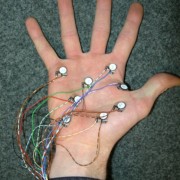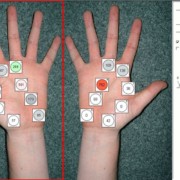Contact Point Handlebar
The handlebar is the point of contact on which the cyclist’s hands rest, it is the point where the force of the shoulders, the forearms and the upper arms indirectly operate. However, the hands’ capacities as ‘load carrier’ is limited. The rider’s position on the bike is largely responsible for the intensity with which hands and arms are strained when cycling. When sitting rather upright, the pressure on the hands is hardly important. In this case, the handlebar serves as a slight support and is ultimately used to steer only. The other extreme is the grip in the handelbar’s drop on a road bike. In this position the hands need to carry a relatively large portion of the weight of the body’s upper part. Also in a triathelete’s position the bulk of the weight rests on the handlebar, while the hands are relieved through the additional pads supporting the forearms. But also in less extreme positions like the standard road biking position, the hands may be subject to high pressure. Through this punctually high pressure nerve vessels can be clamped, resulting in prickling or numb fingers.
Purely a Question of Nerves
Prickling and numb fingers are primarily the result of the overstressing of two nerve vessels: the median nerve (pictured red) runs just below the skin through the carpal tunnel. It can be found in the area of the hand’s inner thenar and is responsible for the supply of thumb, index and middle finger. When cycling it is important to reduce the pressure on this nerve to ensure a firm grip on the handlebar and the break levers.
The ulnar nerve (pictured green) runs below the outer thenar and supplies the fourth and the little finger. In case there is a high punctual pressure on the outer thenar, there will be an increased prickling in the hand’s outside and in these two fingers.
Due to its small supporting area and its low curvature radius the handlebar is, from a measuring point of view, the most problematic point of contact. However, in first experiments the pressure values between hands and handlebars has been measured successfully. To do so individual sensors have been glued onto the subjects’ hands, their signals were transferred via radio and saved on the computer.
Such measurements can be used to evaluate and improve the effects of different bike adjustments (such as the stem’s length, the handlebar’s angle and the positioning of the brake levers), different supporting areas (triathlon bars, gripping positions) or of different glove pads. Due to the individual wiring of each sensor, this method of measurement is rather laborious and needs to be conducted carefully. Nonetheless, in a laboratory setting this method can be used to analyse different handlebar types or settings or to select the fitting gloves.



